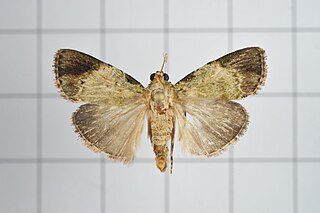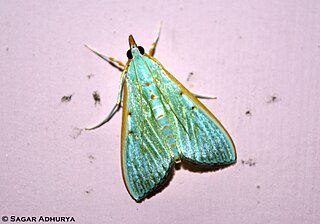Achroia innotata is a species of snout moth, known from Sarawak, Malaysia, Sri Lanka and South Africa. It was described by Francis Walker in 1864.
Azamora is a genus of snout moths. It was described by Francis Walker in 1858, and is known from Venezuela, Brazil, Suriname, and French Guinea.
Caphys bilineata is a species of snout moth. It was described by Caspar Stoll in 1781. It is found in much of Central America and South America, including Arizona, Honduras, Panama, Bahamas, Cuba, Grenada, Guadeloupe, Puerto Rico, Saint Vincent, Brazil, Chile, Colombia, Ecuador, Peru, Suriname and Venezuela.
Azamora bilinealis is a species of snout moth in the genus Azamora. It was described by Hans Georg Amsel in 1956, and is known from Venezuela.
Azamora corusca is a species of snout moth in the genus Azamora. It was described by Julius Lederer in 1863, and is known from Venezuela and Brazil.
Azamora pelopsana is a species of snout moth in the genus Azamora. It was described by Francis Walker in 1863, and is known to be from Brazil.
Azamora tortriciformis is a species of snout moth in the genus Azamora. It was described by Francis Walker in 1858, and is known from Brazil.

Hypsopygia albidalis is a species of snout moth in the genus Hypsopygia. It was described by Francis Walker in 1866 and is known from Australia.
Lamida moncusalis, the cashew shoot and blossom webber, is a species of snout moth in the genus Lamida. It was described by Francis Walker in 1859. It is found in India.
Loxostege commixtalis, the alfalfa webworm, is a species of moth in the family Crambidae. It was described by Francis Walker in 1866. It is found in Fennoscandia, Estonia and northern Russia. It is also found in North America, where it ranges from Nova Scotia and Newfoundland and Labrador west to the Yukon.

Pyrausta phoenicealis, the perilla leaf moth, is a moth of the family Crambidae described by Jacob Hübner in 1818. It is found worldwide, including the Americas, Africa, Australia and Asia.

Orthaga euadrusalis, the mango leaf webber, is a species of snout moth in the genus Orthaga. It was described by Francis Walker in 1858. It is found on Borneo and in India.

Parapoynx crisonalis is a moth in the family Crambidae. It was described by Francis Walker in 1859. It has a wide range and has been recorded from India, Sri Lanka, Thailand, Indonesia, China, Taiwan, Japan and Australia (Queensland). It has been recorded from Great Britain through accidental import with aquatic plants.

Chalcoela pegasalis, the wasp parasitizer moth, is a moth in the family Crambidae. It was described by Francis Walker in 1859. It is found in Cuba, Jamaica, the French Antilles, Puerto Rico and from southern Ontario and Maryland to Florida, east to Texas and north to Illinois.

Arthroschista hilaralis, also known as the kadam defoliator, is a moth in the family Crambidae. It was described by Francis Walker in 1859. It is found in India, Sri Lanka, Burma, Cambodia, Sumatra, Borneo and in Australia, where it has been recorded from Queensland.

Glyphodes caesalis is a moth in the family Crambidae. It was described by Francis Walker in 1859. It is found in Sri Lanka, mainland India, Myanmar, the Andaman Islands, New Guinea, Bangladesh, Fiji, Hong Kong, Thailand and Australia (Queensland).

Glyphodes pyloalis, the lesser mulberry snout moth, lesser mulberry pyralid or beautiful glyphodes moth, is a moth in the family Crambidae. It was described by Francis Walker in 1859. It is found in Iran, China, Japan, India, Indonesia (Sumatra), Sri Lanka, Taiwan, the Democratic Republic of the Congo, Equatorial Guinea, Mozambique and North America, where it has been recorded from Florida, Maryland, North Carolina, South Carolina and Virginia.
Herpetogramma hipponalis is a moth in the family Crambidae. It was described by Francis Walker in 1859. It is found in Malaysia, China, the Keeling Islands, Guadalcanal, New Guinea and Australia, where it has been recorded from the Northern Territory and Queensland.
Herpetogramma stultalis is a moth in the family Crambidae. It was described by Francis Walker in 1859. It is found in Malaysia, India, Sri Lanka, China, Japan, Pakistan, Papua New Guinea and Australia, where it has been recorded from Queensland. In Africa, it has been recorded from the Democratic Republic of the Congo and Réunion.
Omiodes poeonalis is a moth in the family Crambidae. It was described by Francis Walker in 1859. It is found in the Democratic Republic of the Congo, Sierra Leone, Tanzania, the Chagos Archipelago, China, Indonesia, Sri Lanka, Japan and Australia (Queensland).







